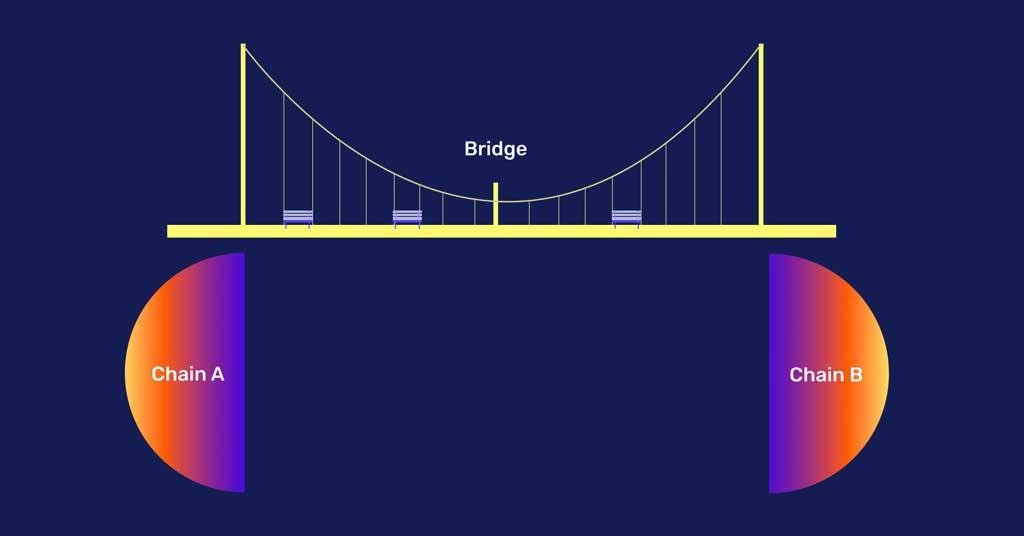Inter-chain bridges, also known as blockchain bridges, are a protocol that connects two blockchains. Thus, users can seamlessly transfer their digital assets and information across chains.
What are Blockchain Bridges?
Cross-chain bridges, also known as blockchain bridges, are a protocol that connects two blockchains and allows users to transfer digital assets and information from one blockchain to another. In other words; It is a “middleman” that connects different blockchains, facilitating token transfers, smart contracts, data exchange, as well as communication between two independent chains.
For example, if you want to spend your Bitcoins on the Ethereum blockchain, you need a cross-chain bridge. This bridge wraps BTC, making your desired transaction possible.
The popularity of cross-chain bridges has increased in part following the rise of “alternative” first-tier blockchains such as Solana, Avalanche, and BNB Chain. Broadly speaking, having access to multiple blockchains over a single network improves users’ experience, increases liquidity for DApps and increases the efficiency of assets.

How Does a Cross-Chain Bridge Work?
The most common use of cross-chain bridges is utility token transfer. It is also used for transactions such as converting smart contracts and sending data.
If we go through the example given above; Bitcoin in your possession cannot be transferred to the Ethereum network. The cross-chain bridge allows your BTC to be converted and used on the Ethereum network without exposing it to the procedures of a centralized exchange. It works by wrapping coins in a smart contract and then issuing native assets that can be used on another preferred blockchain.
Why Are Blockchain Bridges Important For Cryptocurrencies?
To understand the importance of cross-chain bridges in the crypto space, it is necessary to understand how interoperability empowers seamless transactions in traditional finance. You can use your Visa to pay your Mastercard bills, although it is not very noticeable in daily life. Similarly, you can use PayPal to pay for almost any of your online purchases, regardless of where you buy them from. These are all different companies operating different systems and protocols. However, transactions proceed quickly and smoothly.
The lack of interoperability between different blockchains is seen as one of the barriers to mass adoption of cryptocurrencies. Because there is no doubt that solutions such as cross-chain bridges are a big step towards wider adoption of blockchain technology.
Blockchain bridges help reduce transaction costs while providing a better user experience. Imagine having to go through different exchanges every time you need to trade a coin; Aside from the high transaction fees that come with doing this every time, the whole process is rather cumbersome.
Overall, cross-chain bridges allow users to combine the positive aspects of two different blockchains, such as higher transaction throughput, lower transaction fees, and better utility in the form of dApps.

Best Blockchain Bridges
As with blockchains, there are numerous cross-chain protocols. The picture above gives an idea of the number of blockchain bridges running on different networks. CoinMarketCap lists the best blockchain bridges by frequency and popularity as follows:
1. Portal Token Bridge (formerly Wormhole)
Despite the hacking incident, Portal continued to be one of the most popular cross-chain bridges in the ecosystem. Although originally built on the Solana Network for bidirectional crypto token transfers between Solana and Ethereum, the multi-chain now connects more than ten blockchains, including Solana, Ethereum, BNB Chain, Polygon, Avalanche, Oasis and more. The portal uses proprietary validators known as guardians to provide a robust cross-chain exchange experience to its users. These guards monitor activity on the bridge and validate user requests. And in addition to its simple interface, the Portal token bridge also offers competitive transaction fees of $0.0001 per transfer. The protocol has so far processed over $400,000.
2. Binance Bridge
Coming from the world’s leading exchange, Binance Bridge is an Ethereum-BNB Chain Bridge that allows anyone to convert to BNB Chain and other BSC compatible formats. The bridge charges zero fees for transactions. Users only need to pay gas fees in local and destination chains.
3. Avalanche Bridge
Avalanche Bridge is a two-way cross-chain bridge between Avalanche and the Ethereum network. It uses ChainSafe’s ChainBridge to enable two-way transfer of both cryptocurrencies and NFTs. The protocol depends on the relays to secure the bridge. These relays (Protofire, Hashquark, POA Network, Avascan) compare the offer to trade assets with Avalanche’s data and approve or reject the offer through a voting process. This additional voting process makes Avalanche one of the safest crypto bridges in the space.
4. Phantom AnySwap Bridge
Like Avalanche Bridge, Fantom’s AnySwap is a bidirectional solution that facilitates cross-chain transfers between the Ethereum Network and the EVM-capable Fantom Network.
AnySwap provides a multi-chain liquidity solution and uses liquidity pools to enable cross-chain swaps. Liquidity pools distributed on various blockchain networks facilitate transfer from Ethereum, Avalanche, Polygon and BNB Chain to Fantom.







